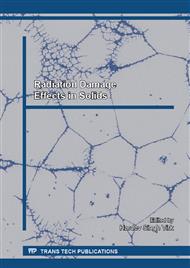[1]
G.E. Possin, A Method for Forming Very Small Diameter Wires, Rev. Sci. Instrum. 41 (1970) 772-778.
Google Scholar
[2]
S. Kawai, R. Ueda, Magnetic Properties of Anodic Oxide Coatings on Aluminum Containing Electrodeposited Co and Ni, J.Electrochem. Soc. 112 (1975) 32-36.
DOI: 10.1149/1.2134152
Google Scholar
[3]
B.E. Fischer, R. Spohr, Production and use of nuclear tracks: imprinting structure on solids, Rev. Mod. Physics 55(1983) 907-948.
DOI: 10.1103/revmodphys.55.907
Google Scholar
[4]
G.N. Flerov, Synthesis of super elements and application of nuclear physics methods in relative fields, Vestnik AN SSSR 4 (1984) 35-49.
Google Scholar
[5]
B.V. Mchedlishvili, V.V. Beryozkin, V.A. Oleinikov, A.I. Vilensky, A.B. Vasilyev, Structure, physical and chemical properties and applications of nuclear filters as new class of Membranes, J. Membrane Science 79 (1993) 285-304.
DOI: 10.1016/0376-7388(93)85122-d
Google Scholar
[6]
J. Vetter, R. Spohr, Application of ion track membranes for preparation of metallic Microstructures, Nucl. Instrum.Meth. Phys. Res. B 79 (1993) 691- 694.
Google Scholar
[7]
T.M. Whitney, J.S. Jiang, P.C. Searson, C.L. Chien, Fabrication and Magnetic Properties of Arrays of Metallic Nanowires, Science 261 (1993) 1316-1320.
DOI: 10.1126/science.261.5126.1316
Google Scholar
[8]
C.R. Martin, Nanomaterials: A Membrane-Based Synthetic Approach, Science 266 (1994) 1961-1966.
Google Scholar
[9]
G.N. Akapiev, S.N. Dmitriev, B. Erler, V.V. Shirkova, A. Schulz, H. Pietsch, Ion track membranes providing heat pipe surfaces with capillary structures, Nuclear Instrum. Meth. Phys. Res. B 208 (2003) 133-136.
DOI: 10.1016/s0168-583x(03)01182-0
Google Scholar
[10]
A. Schulz, G.N. Akapiev, V.V. Shirkova, H. Rosler, S.N. Dmitriev, A new method of fabrication of heat transfer surfaces with micro-structured profile, Nuclear Instrum. Meth. Phs. Res. B 236 (2005) 254-258.
DOI: 10.1016/j.nimb.2005.04.049
Google Scholar
[11]
P. Ndungu, W. Davids, M. Nkosi M, A. Nechaev, G. Vaivars, V. Linkov, Template Synthesis of Nickel Nano-/Micro-wires: Catalysts for the Growth of Carbon Nanotubes, Pyrolysis of Liquid Petroleum Gas 24 (2007) 185-189.
Google Scholar
[12]
V.A. Oleinikov, N.V. Pervov, B.V. Mchedlishvili, Track membranes for template synthesis of optical-active structures, Membranes (in Russian) 24, N4 (2004) 17-28.
Google Scholar
[13]
V.A. Oleinikov, Yu.V. Tolmachyova, V.V. Berezkin, A.I. Vilensky, B.V. Mchedlishvili, Polyethileneterephthalate track membranes with conical pores: etching by water-alcohol alkali solutions, Rad. Meas. 25, N1-4 (1995) 713-714.
DOI: 10.1016/1350-4487(95)00227-6
Google Scholar
[14]
A. Vilenski, Yu. Kochnev, S. Vlasov, B. Mchedlishvili, Electrolytes for etching of heavy ions latent tracks in polyethyleneterephtalate. Surface (Translated from Russian "Poverchnost") 10 (2008) 1-4.
Google Scholar
[15]
J.B. Fenn, M. Mann, C.K. Meng, S.F. Wong, C.M. Whitehouse, Electrospray ionization for mass spectrometry of large biomolecules, Science 246 (1989) 64-71.
DOI: 10.1126/science.2675315
Google Scholar
[16]
B. Domon, R. Aebersold, Mass spectrometry and protein analysis, Science 312 (2006) 212- 217.
DOI: 10.1126/science.1124619
Google Scholar
[17]
R. Kaufmann, Matrix-assisted laser desorption ionization (MALDI) mass spectrometry: A novel analytical tool in molecular biology and biotechnology, J. Biotechnol. 41 (1995) 155- 175.
DOI: 10.1016/0168-1656(95)00009-f
Google Scholar
[18]
P. Kraft. S. Alimpiev, E. Dratz, J. Sunner, Infrared, Surface-Assisted Laser Desorption Ionization Mass Spectrometry on Frozen Aqueous Solutions of Proteins and Peptides using Suspensions of Organic Solids, J. Am. Soc. Mass. Spectrom. 9 (1998) 912–924.
DOI: 10.1016/s1044-0305(98)00063-4
Google Scholar
[19]
S.A. Trauger, E.P. Go, Z. Shen, J.V. Apon, B.J. Compton, E.S.P. Bouvier, M.G. Finn, G. Siuzdak, High Sensitivity and Analyte Capture with Desorption/Ionization Mass Spectrometry on Silylated Porous Silicon, Anal. Chem. 76 (2004) 4484-4489.
DOI: 10.1021/ac049657j
Google Scholar
[20]
V.A. Oleinikov , D.L. Zagorski, S.A. Bedin, A.A. Volosnikov , P.A. Emelyanov, Y.P. Kozmin, B.V. Mchedlishvili, The study of the desorption/ionization from the replicas of etched ion tracks, Rad. Meas. 43 (2008) S635-S638.
DOI: 10.1016/j.radmeas.2008.04.018
Google Scholar


